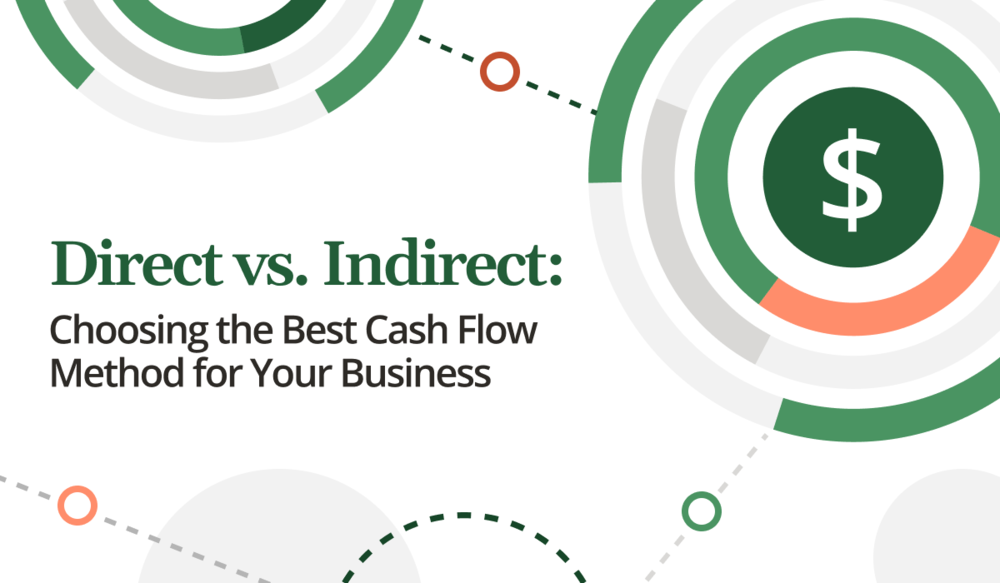
It may not always get the most love, but your cash flow statement is a vital part of your reporting story. That's why, in this post, we're going to talk all about choosing the best cash flow method for your business. Direct, or indirect.
Among the main trifecta of financial reports--the balance sheet, income statement and cash flow statement--it's often the statement of cash flow that gets the least attention and time. But as a view into your company's liquidity, it provides an important piece of the puzzle.
And extracting the information you need? This begins with putting the right process in place to build the best cash flow statement for your business--in whatever time you have. That starts by choosing between the direct and indirect cash flow methods.
So what's the difference between direct and indirect?
While both are ways of calculating your net cash flow from operating activities, the main distinction is the starting point and types of calculations each uses.
The indirect method begins with your net income.
Alternatively, the direct method begins with the cash amounts received and paid out by your business.
Each uses a separate set of calculations from there to get to the same finish line, revealing different details along the way. Let's look at each in turn.
The indirect cash flow method starts with your organization's net income. It then makes adjustments to get to the cash flow from operating activities. Those adjustments consider things such as depreciation and amortization, changes in inventory, changes in receivables and changes in payables.
Once you're done with the adjustments, you end up with a final closing bank position.
The benefit of the indirect method is that it lets you see why your net profit is different from your closing bank position. But because it's based on adjustments, one of its disadvantages is that it doesn't offer the same visibility into cash transactions or break down their sources.
Without that fine detail, there are insights you may be missing out on.
The direct method individually itemizes the cash received from your customers and paid out for supplies, staff, income tax, etc. Non-cash transactions are ignored. And again, a closing bank statement emerges--the same closing bank statement you'd get using the indirect method.
An advantage of the direct method is that it gives you more visibility of your cash inflow and outflow--something that can benefit your short-term planning, enabling you to identify and analyze any potential challenges or opportunities that might exist for future cash flow.
Mastering cash flow management is something every business will benefit from.
A better view of the past helps you forecast for the future.
But it's also more time-consuming for your team because it requires looking beyond the balance sheet and income statement account activity you already know so well.
In the end, both the indirect and direct cash flow methods get you to the same number. So how do you decide which method will work best for you?
Factors like the industry you're working in and the audience you're reporting for (whether management or banks, auditors or shareholders) will make a difference. And so will the data you have available and the insights you hope to generate.
But there are a few other factors to consider as well:
What's right for your team will be up to you. Most larger companies choose the indirect method, at least in part because of the lower time investment, while analysts often prefer it as well because it lets them see for themselves what adjustments have been made.
The direct method, on the other hand, is often the best choice for smaller businesses, as the transparency into operating cash flow details helps them better determine their short-term cash availability planning needs.
Your cash flow statement tells a critical part of your financial story, no matter which approach you use. It can also give you the ultimate flexibility to run your business responsibly.
A negative cash flow statement can be a strong indicator that your company's not in a good position for a potential economic downturn or market shift. It can also mean you need to look into other financing options.
It also empowers your investors, creditors, and stakeholders with the information they need to understand whether you have the cash available to pay off your loans if you can pay your employees, or how you measure up to your peers.
Whether you choose to use the indirect or direct method will affect the way you operate your cash flow and the story you tell around it. So make sure you choose the method that puts you in the best place to help your business succeed.
Do you want to talk more about choosing the right financial solutions for your business? Take a look at Vena's financial reporting solutions here, or reach out to discuss what's right for you.
Did you learn a lot about the different cash flow methods in this post? Here are three more posts to read next: